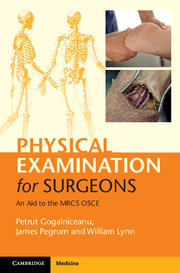Book contents
- Frontmatter
- Dedication
- Contents
- List of contributors
- Introduction
- Acknowledgments
- List of abbreviations
- Section 1 Principles of surgery
- Section 2 General surgery
- Section 3 Breast surgery
- Section 4 Pelvis and perineum
- Section 5 Orthopaedic surgery
- 14 Generic joint examination
- 15 Examination of gait
- 16 Examination of the cervical and thoracic spine
- 17 Cervical spine injury: assessment in trauma
- 18 Examination of the shoulder
- 19 Examination of the elbow
- 20 Examination of the lumbar spine and sacroiliac joint
- 21 Examination of the hip
- 22 Examination of the knee
- 23 Examination of the ankle
- Section 6 Vascular surgery
- Section 7 Heart and thorax
- Section 8 Head and neck surgery
- Section 9 Neurosurgery
- Section 10 Plastic surgery
- Section 11 Surgical radiology
- Section 12 Airway, trauma and critical care
- Index
18 - Examination of the shoulder
from Section 5 - Orthopaedic surgery
Published online by Cambridge University Press: 05 July 2015
- Frontmatter
- Dedication
- Contents
- List of contributors
- Introduction
- Acknowledgments
- List of abbreviations
- Section 1 Principles of surgery
- Section 2 General surgery
- Section 3 Breast surgery
- Section 4 Pelvis and perineum
- Section 5 Orthopaedic surgery
- 14 Generic joint examination
- 15 Examination of gait
- 16 Examination of the cervical and thoracic spine
- 17 Cervical spine injury: assessment in trauma
- 18 Examination of the shoulder
- 19 Examination of the elbow
- 20 Examination of the lumbar spine and sacroiliac joint
- 21 Examination of the hip
- 22 Examination of the knee
- 23 Examination of the ankle
- Section 6 Vascular surgery
- Section 7 Heart and thorax
- Section 8 Head and neck surgery
- Section 9 Neurosurgery
- Section 10 Plastic surgery
- Section 11 Surgical radiology
- Section 12 Airway, trauma and critical care
- Index
Summary
Checklist
WIPER
• Patient standing in shorts or underwear with shoulder girdle exposed (bra to remain on in women).
• Expose upper limb and cervical spine.
Physiological parameters
• Observe for spinal lordosis, kyphosis or scoliosis.
Look
• Skin: erythema, scars, sinuses, symmetry of skin creases or skin elevation from underlying fracture
• Soft tissues:
• joint and soft tissue swelling
• wasting of deltoid, biceps, supraspinatus and infraspinatus muscles
• Bone: prominence of acromion, clavicular asymmetry or deformity
Feel
• Skin: temperature, tenderness, sensation
• Soft tissues:
• muscle mass: trapezius, deltoid, triceps, biceps and biceps tendon
• ligaments: coracoclavicular ligaments
• radial and ulnar pulses, capillary refill time
• sensation in ‘regimental badge' area (axillary nerve) and in hand
• Bone:
• sternoclavicular joint
• clavicle: deformity or malunion
• acromioclavicular joint
• coracoid process
• spine and borders of the scapula
• greater tuberosity of humerus
• margins of glenoid cavity
• cervical spine
Move
• Active and passive:
• flexion/extension
• internal/external rotation
• abduction/adduction
• Resisted:
• deltoid
• serratus anterior (winging of the scapula)
• pectoralis major
• trapezius
Special tests (* = essential tests)
• Acromioclavicular test*
• Impingement test*
• Instability and apprehension test*
• Rotator cuff test*
• Biceps tendon test
• SLAP test
• Thoracic outlet syndrome tests
To complete the examination…
• Examine the joint above (cervical spine: up to 30% of shoulder pain is referred from the cervical region) and the joint below (elbow).
• Check full neurovascular status of the upper limb.
• Order appropriate radiographs and further imaging.
Examination notes
What do you look for during initial observations?
• Assess the skin quality and contours of the shoulder girdle, clavicle and scapula.
• The soft tissues mass and muscle bulk are evaluated for evidence of muscle loss from disuse atrophy, found around the scapular from rotator cuff atrophy or pectoral muscles anteriorly. Deltoid muscle atrophy can also be found in axillary nerve injury.
- Type
- Chapter
- Information
- Physical Examination for SurgeonsAn Aid to the MRCS OSCE, pp. 140 - 151Publisher: Cambridge University PressPrint publication year: 2015



